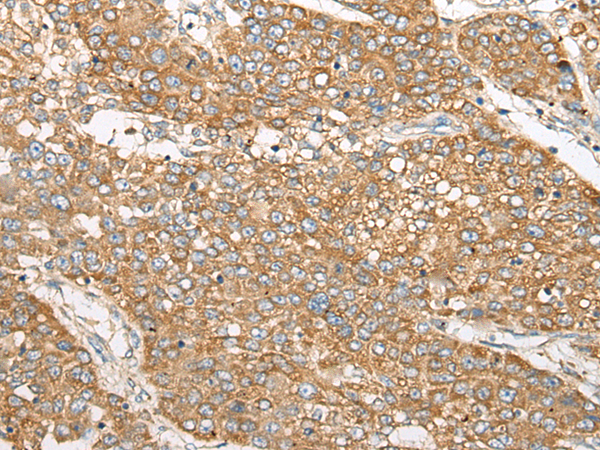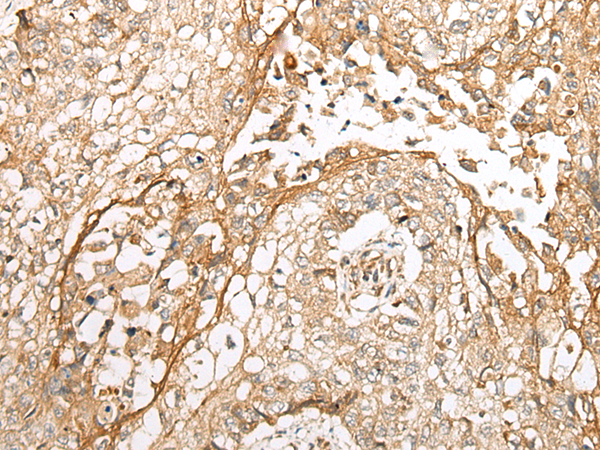


| WB | 咨询技术 | Human,Mouse,Rat |
| IF | 咨询技术 | Human,Mouse,Rat |
| IHC | 1/25-1/100 | Human,Mouse,Rat |
| ICC | 技术咨询 | Human,Mouse,Rat |
| FCM | 咨询技术 | Human,Mouse,Rat |
| Elisa | 1/5000-1/10000 | Human,Mouse,Rat |
| Aliases | WBP-1 |
| WB Predicted band size | 29 kDa |
| Host/Isotype | Rabbit IgG |
| Antibody Type | Primary antibody |
| Storage | Store at 4°C short term. Aliquot and store at -20°C long term. Avoid freeze/thaw cycles. |
| Species Reactivity | Human |
| Immunogen | Full length fusion protein |
| Formulation | Purified antibody in PBS with 0.05% sodium azide and 50% glycerol. |
+ +
以下是关于WBP1抗体的3篇参考文献的简要概括:
1. **文献名称**: *WBP1 interacts with the cytoplasmic domain of amyloid precursor protein and promotes its lysosomal degradation*
**作者**: Liu Y. et al.
**摘要**: 研究利用WBP1抗体证实了WBP1蛋白与淀粉样前体蛋白(APP)的相互作用,揭示其通过调控APP的溶酶体降解途径影响阿尔茨海默病相关病理过程。
2. **文献名称**: *WW domain-binding protein 1 promotes cell proliferation by regulating the stability of the Yes-associated protein*
**作者**: Chen D. et al.
**摘要**: 通过WBP1抗体检测,发现WBP1通过稳定YAP蛋白(Hippo信号通路核心分子)促进肿瘤细胞增殖,为癌症治疗提供潜在靶点。
3. **文献名称**: *WBP1 is a novel regulator of the unfolded protein response in breast cancer*
**作者**: Wang L. et al.
**摘要**: 利用WBP1抗体进行免疫印迹分析,发现WBP1在内质网应激反应中调控未折叠蛋白反应(UPR),影响乳腺癌细胞存活和化疗耐药性。
这些文献均通过WBP1抗体探讨了该蛋白在不同疾病中的分子机制。
The WW domain-binding protein 1 (WBP1) is a ubiquitously expressed adaptor protein known for its role in mediating protein-protein interactions, particularly through its binding to WW domains found in various signaling and regulatory proteins. WBP1 was initially identified as a partner of the Yes kinase-associated protein (YAP) and later linked to the Nedd4 family of E3 ubiquitin ligases, which are involved in substrate recognition during ubiquitination. Structurally, WBP1 contains multiple PPxY motifs that enable its interaction with WW domains, facilitating processes such as protein trafficking, transcriptional regulation, and post-translational modifications like ubiquitination. Dysregulation of WBP1 has been implicated in cancer, neurodegenerative disorders, and cardiovascular diseases, where it may influence cell proliferation, apoptosis, or stress response pathways.
WBP1 antibodies are essential tools for studying the protein's expression, localization, and function in these contexts. They are widely used in techniques such as Western blotting, immunohistochemistry, and immunoprecipitation to detect WBP1 in biological samples. Some antibodies specifically target post-translational modifications (e.g., phosphorylation) or distinct isoforms of WBP1. aiding in mechanistic studies. Research utilizing WBP1 antibodies has contributed to understanding its role in modulating pathways like the Hippo signaling cascade and its interplay with oncogenic or tumor-suppressive networks. Validated WBP1 antibodies are critical for exploring its potential as a therapeutic target or diagnostic biomarker in disease models.
×